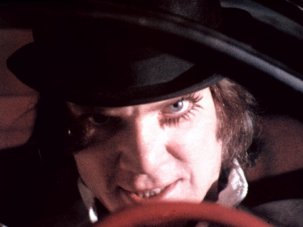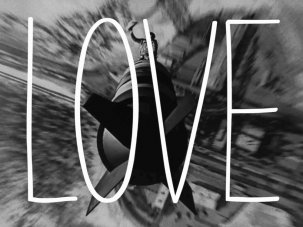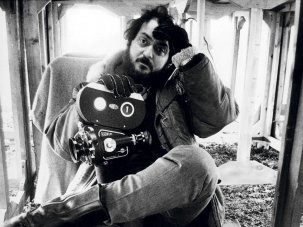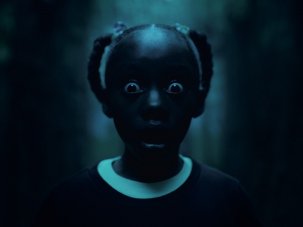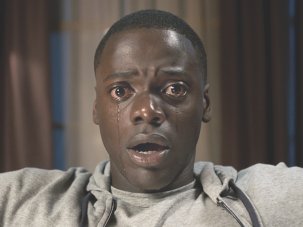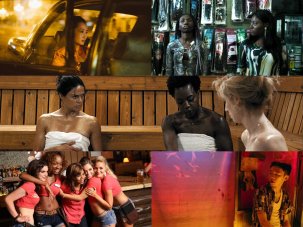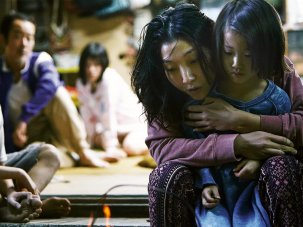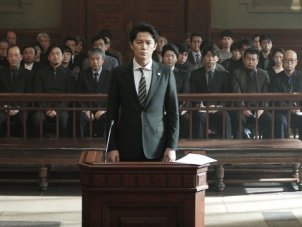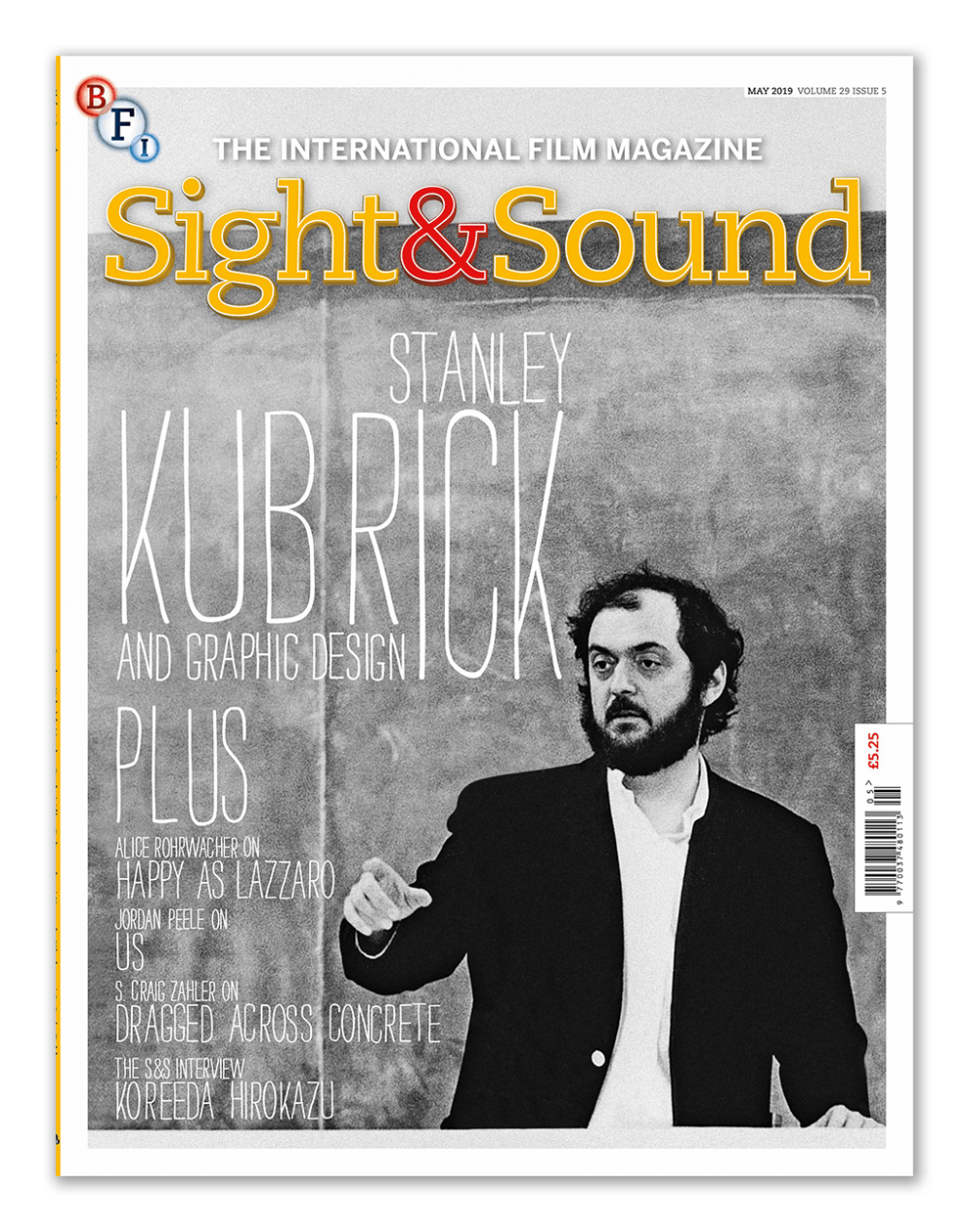
What makes a director an auteur? For the great Stanley Kubrick it meant complete control of your film at every stage and in every visual element and that is famously what he practiced.
Posted to subscribers and available digitally 1 April
→ Buy a print edition
→ Access the digital edition
→
On UK newsstands 4 April
To coincide with a complete BFI Southbank retrospective of Kubrick’s films, including the re-release of A Clockwork Orange, our cover feature by Rick Poyner explores Kubrick’s relationship with title design maestro Saul Bass and the obsessive attention the director paid to the design elements of titles, posters and other publicity materials for all his films.
Another neglected aspect of Kubrick’s work is his fascination with the male body. Christina Newland considers the boxers in Day of the Fight, Kirk Douglas’s figure in Spartacus, the full-frontal nudity in Eyes Wide Shut and other physically impressive moments, seeing Kubrick’s work as a treasure trove of Freudian imagery, from Dr. Strangelove’s cigars to Barry Lyndon’s pistols and bayonets.
The zeitgeist film of the moment is Jordan Peele’s creepy horror allegory Us, which portrays the otherworldly possibility of doppelgangers in revolt. Simran Hans talks big scares and political themes with Peele and explores a career that’s taken him from the comedy sketch show Key and Peele to his hosting of the imminent reboot of TV’s The Twilight Zone. “If I’m going to go and watch something,” Peele tells her, “it’s generally high concept, fun, genre; something committed, something clever.” And that, of course, is the core of what he himself is making.
One of the most talked about films at recent festivals is Alice Rohrwacher’s strange and beautiful fable Happy as Lazzaro, set in the milieu of ingrained relationships between owners and employees at first on a tobacco farm and later in the industrial city. Rohrwacher tells Philip Concannon about the milking of human kindness and the wind that makes a scene come alive.
By contrast Nick Pinkerton considers the career of S. Craig Zahler, known for its violence and gory content, themes that come to the fore as challenging issues in his droll, observational and murderous cops and race thriller Dragged Across Concrete, which stars, controversially, Vince Vaughn and Mel Gibson.
Features
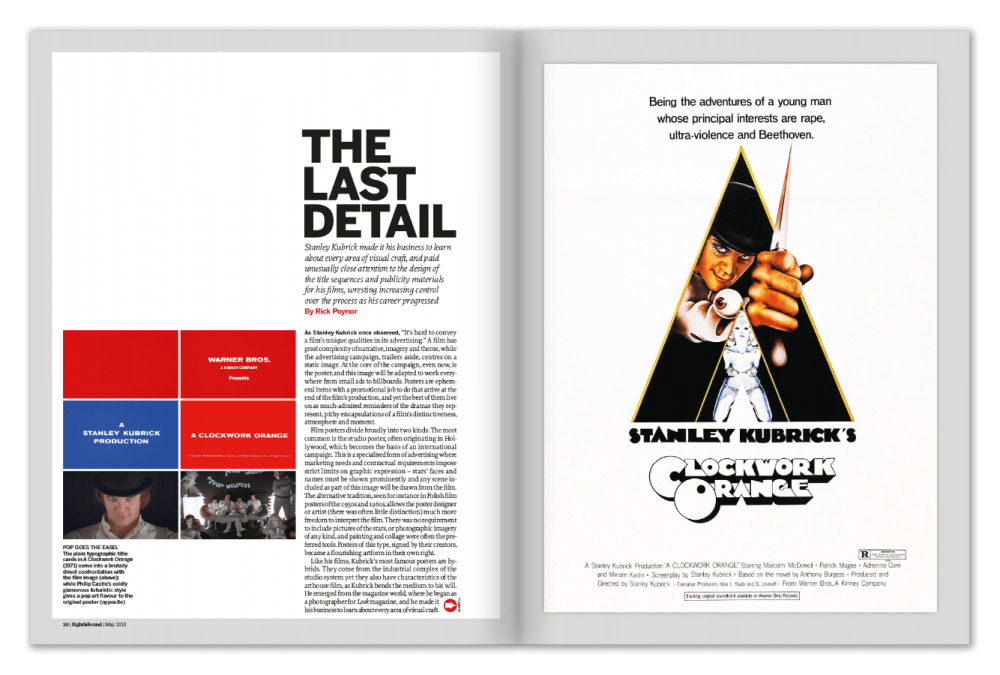
The Last Detail
Stanley Kubrick made it his business to learn about every area of visual craft, and paid unusually close attention to the design of the title sequences and publicity materials for his films, wresting increasing control over the process as his career progressed. By Rick Poynor.
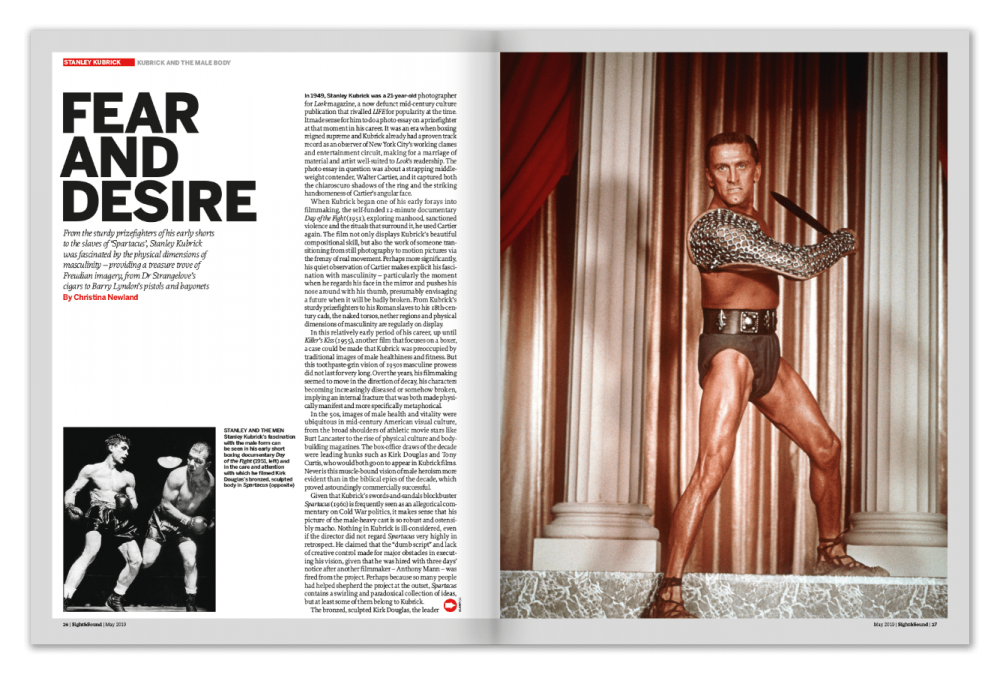
Fear and Desire
From the sturdy prizefighters of his early shorts to the slaves of Spartacus, Stanley Kubrick was fascinated by the physical dimensions of masculinity – providing a treasure trove of Freudian imagery, from Dr Strangelove’s cigars to Barry Lyndon’s pistols and bayonets. By Christina Newland.
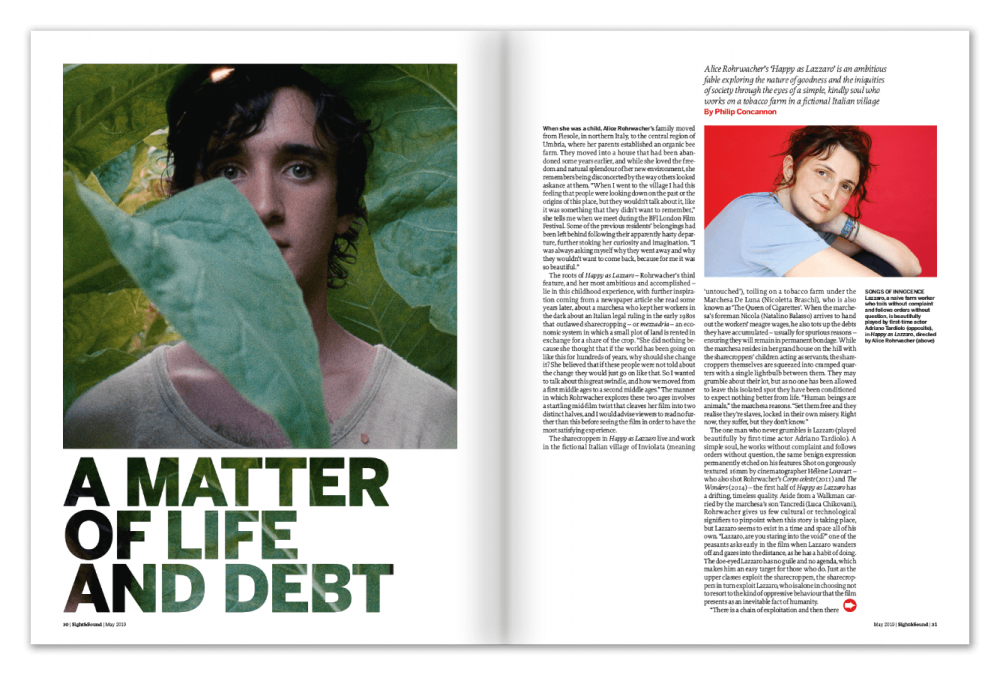
A Matter of Life and Debt
Alice Rohrwacher’s Happy as Lazzaro is an ambitious fable exploring the nature of goodness and the iniquities of society through the eyes of a simple, kindly soul who works on a tobacco farm in a fictional Italian village. By Philip Concannon.
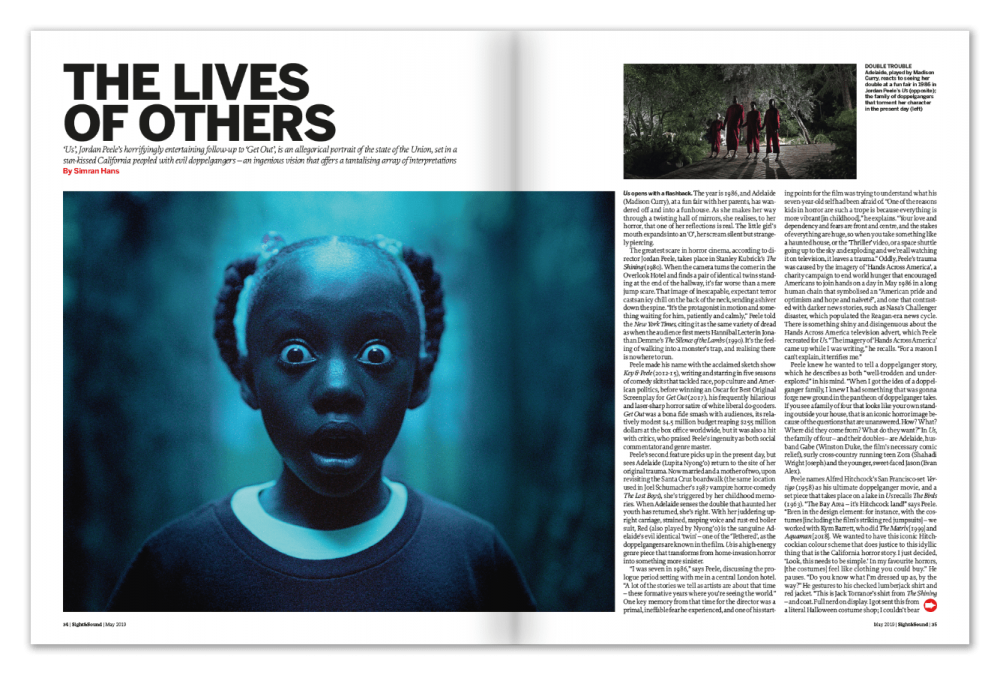
The Lives of Others
Us, Jordan Peele’s horrifyingly entertaining follow-up to Get Out, is an allegorical portrait of the state of the Union, set in a sun-kissed California peopled with evil doppelgangers – an ingenious vision that offers a tantalising array of interpretations. By Simran Hans.
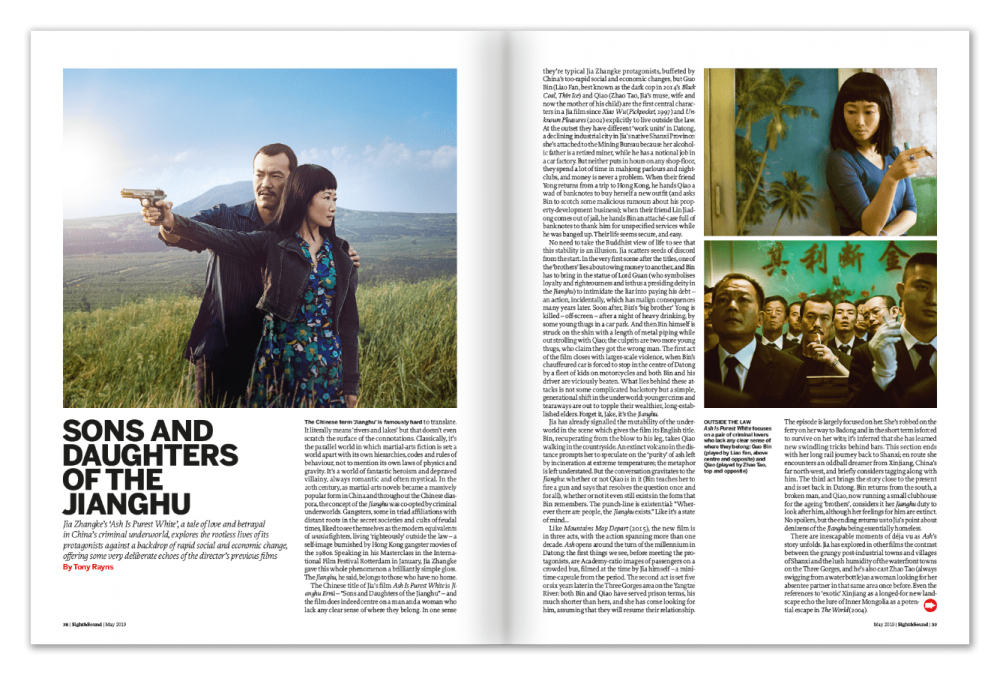
Sons and Daughters of the Jianghu
Jia Zhangke’s Ash Is Purest White, a tale of love and betrayal in China’s criminal underworld, explores the rootless lives of its protagonists against a backdrop of rapid social and economic change, offering some very deliberate echoes of the director’s previous films. By Tony Rayns.
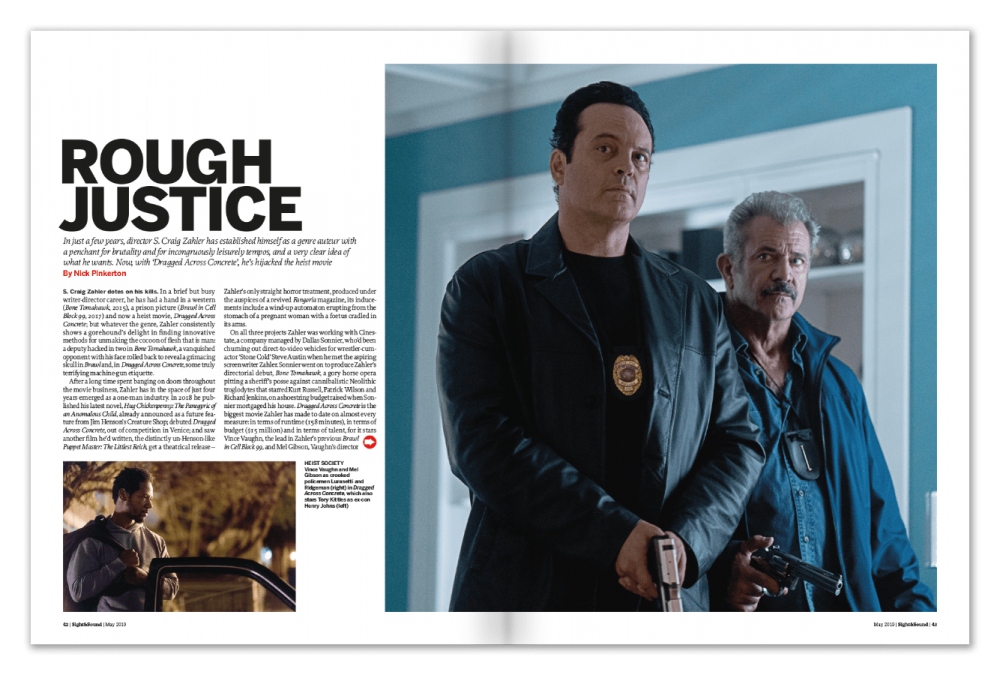
Rough Justice
In just a few years, director S. Craig Zahler has established himself as a genre auteur with a penchant for brutality and for incongruously leisurely tempos, and a very clear idea of what he wants. Now, with Dragged Across Concrete, he’s hijacked the heist movie. By Nick Pinkerton.
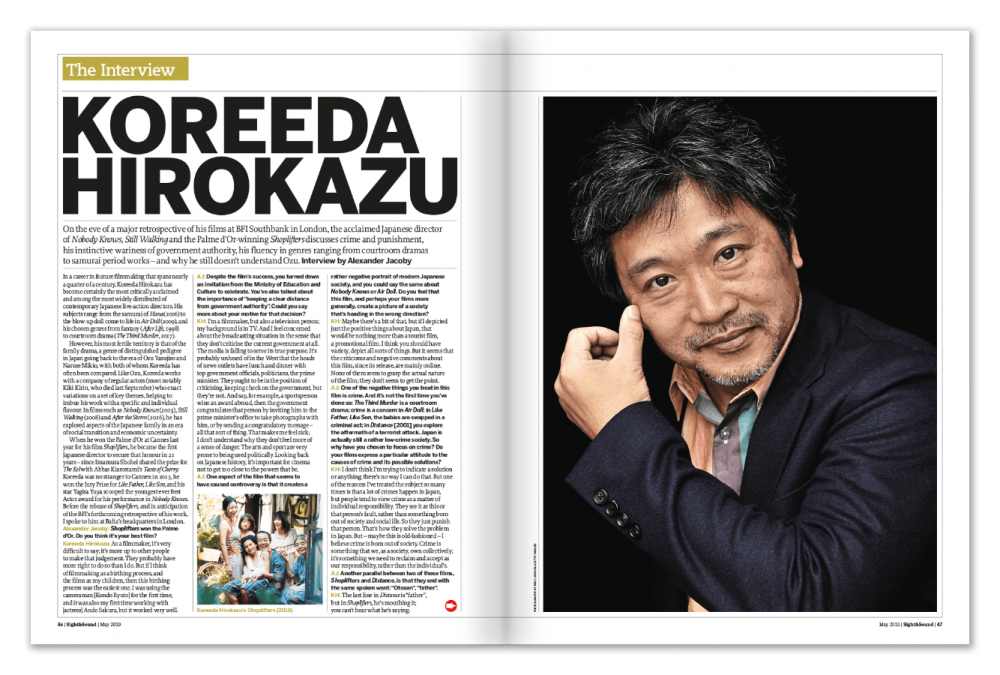
The S&S interview: Koreeda Hirokazu
On the eve of a major retrospective of his films at BFI Southbank in London, the acclaimed Japanese director of Nobody Knows, Still Walking and the Palme d’Or-winning Shoplifters discusses crime and punishment, his instinctive wariness of government authority, his fluency in genres ranging from courtroom dramas to samurai period works – and why he still doesn’t understand Ozu. Interview by Alexander Jacoby.
Regulars
Editorial
Streaming the house down
Rushes
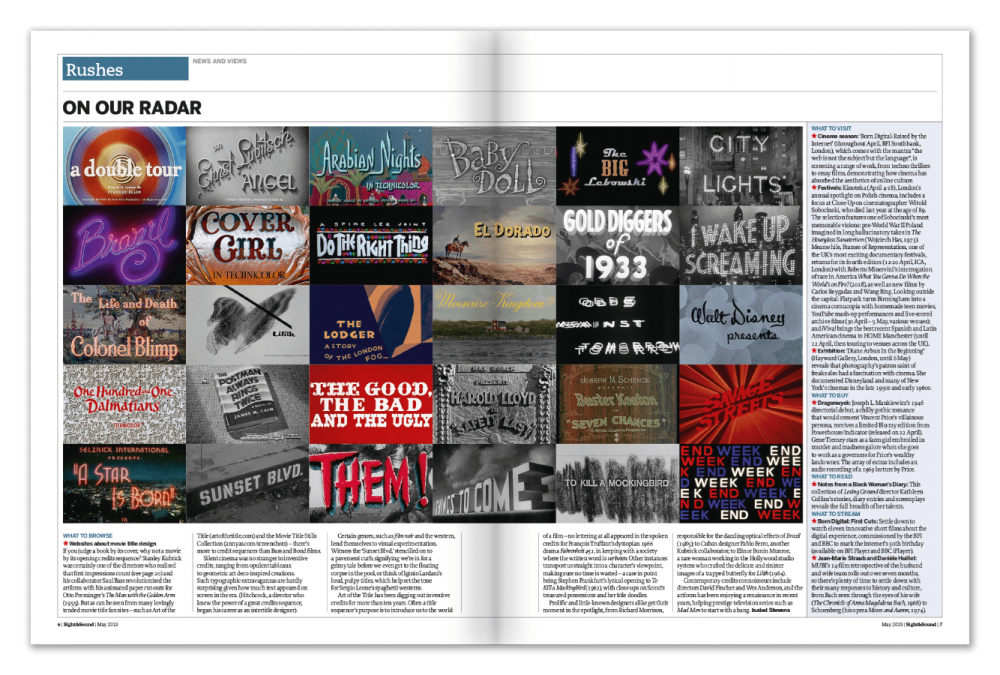
On our Radar
On our radar
Websites about title design, plus what to visit, buy, read, stream and listen to.
Love and friendship
Wanuri Kahiu’s widely praised Rafiki is part of a wave of films representing the complex realities of gay life in Africa. By Lizelle Bisschoff.
Dream palaces: the Nivki, Kiev
The Ukrainian director of A Gentle Creature and Donbass recalls a whimsical moment of truancy as a young student and a hair-raising encounter with Kiev’s Soviet-era authorities during a trip to watch an ‘erotic’ movie. By Sergei Loznitsa.
Body and soul
A Deal with the Universe is a tender documentary about pregnancy – with the difference that its director and subject is a trans man. By Cathy Brennan.
The numbers: Capernaum
Nadine Labaki’s film received a warm welcome from audiences in spite of the heat, the latest success in a sector undergoing major flux. By Charles Gant.
+ Films in production
New projects for Charles Burnett, Lucrecia Martel, Spike Le, Steve Spielberg and Rachel Weisz.
Wide angle
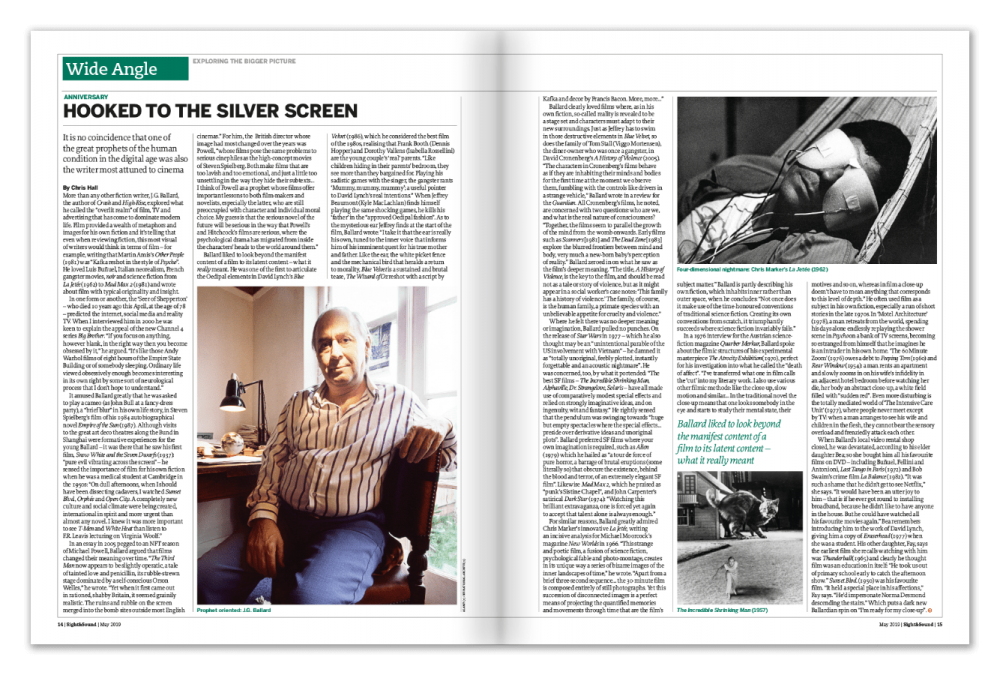
Our Wide Angle section
J.G. Ballard: Hooked to the silver screen
It is no coincidence that one of the great prophets of the human condition in the digital age was also the writer most attuned to cinema. By Chris Hall.
Primal screen: My brilliant career
Her brief career in British film, as one of Hitchcock’s leading ladies, has distracted attention from Anny Ondra’s versatility and longevity. By Pamela Hutchinson.
Exhibition: Out of the shadows
Laura Mulvey and Peter Wollen are best known for their films and writings, but their groundbreaking artworks deserve more attention. By Oliver Fuke and Nicolas Helm-Grovas.
Reviews
Films of the month
Loro
The Sisters Brothers
Wild Rose
plus reviews of
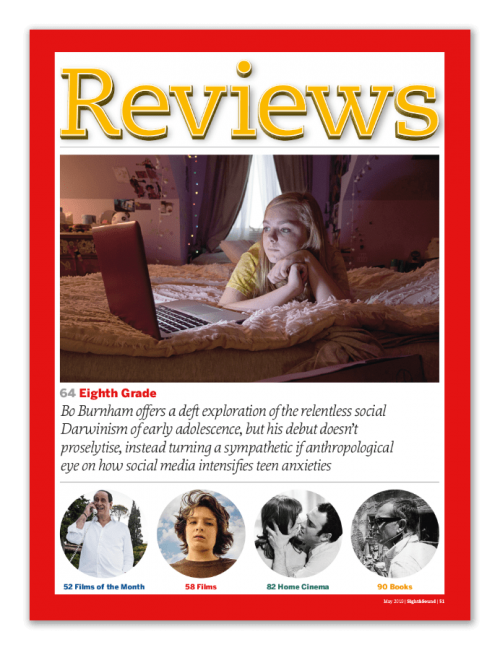
Our Reviews section
Ash Is Purest White
Bel Canto
Ben Is Back
Captain Marvel
Captive State
A Deal with the Universe
The Dig
Donbass
Dragged Across Concrete
Eighth Grade
Fighting with My Family
Five Feet Apart
Greta
Happy as Lazzaro
The Keeper
Last Breath
Lords of Chaos
Mid90s
Nervous Translation
Once upon a Time in London
Pond Life
Red Joan
Steel Country
Styx
Thunder Road
Tolkien
Tucked
Us
Vox Lux
Winterlong
Woman at War
Yuli: The Carlos Acosta Story
Home Cinema features
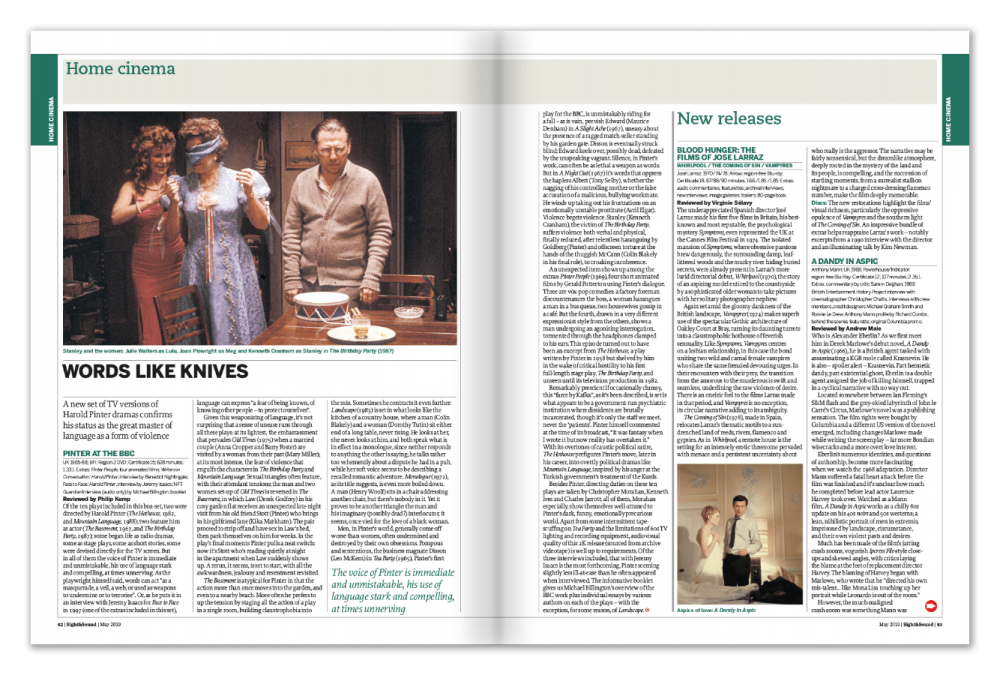
Our Home Cinema section
Words like knives: Pinter at the BBC
A new set of TV versions of Harold Pinter dramas confirms his status as the great master of language as a form of violence. Reviewed by Philip Kemp.
Lapland witches: The White Reindeer
This classic Finnish film, part fairytale, part feminist fable, features a vampire reindeer irresistible to men. Rudolph, it ain’t. Reviewed by Ben Nicholson.
Law of desire: Take a Girl Like You and A Severed Head
A pair of literary adaptations filmed at the end of the Swinging Sixties throw back the covers on sex, morality and fidelity in the era. Reviewed by Robert Hanks.
Lost and found: Pigs
Cathal Black’s debut feature rips up cinema’s picture postcard view of Ireland, replacing it with a dark and angry romanticism. By Brian Quinn.
plus reviews of
Bloodhunger: The Films of Jose Larraz – Whirlpool
The Coming of Sin
Vampyres
A Dandy in Aspic
The Alice Howell Collection
Der Hund von Baskerville
Maurice
Phantom Lady
The Prisoner
Psyche 59
Shoah: The Four Sisters
Television
Robert Hanks reviews Sunshine and Lorna Doone.
Books
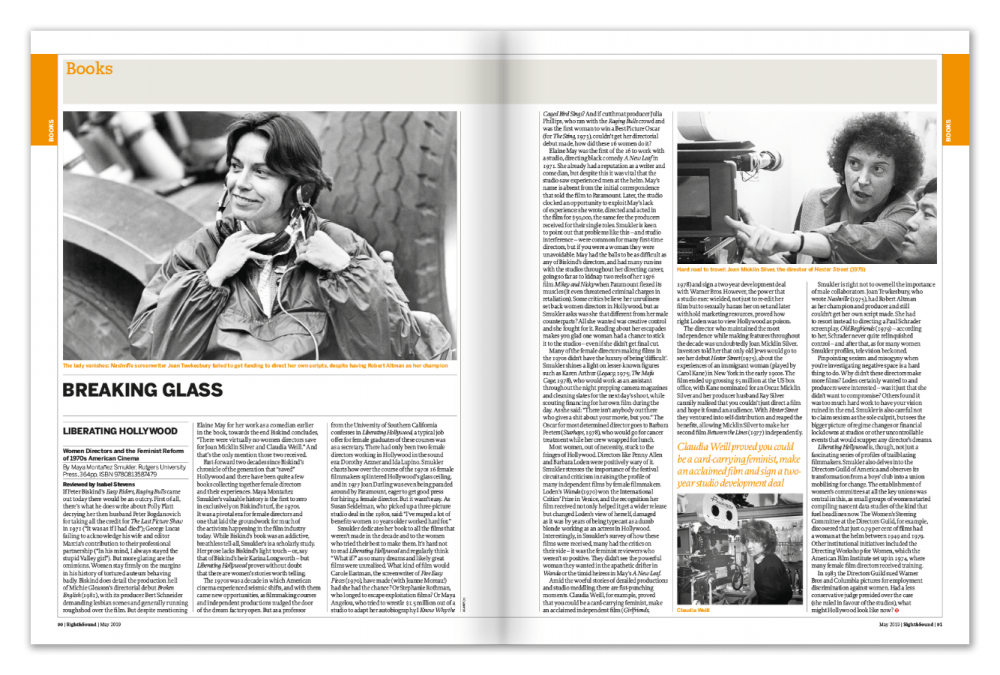
Our Books section
Liberating Hollywood: Women Directors and the Feminist Reform of 1970s American Cinema by Maya Montañez Smukler (Rutgers University Press) reviewed by Isabel Stevens
The Wild Bunch: Sam Peckinpah, a Revolution in Hollywood, and the Making of a Legendary Film by W.K. Stratton (Bloomsbury) reviewed by Tom Charity
Letters
What now constitutes a ‘film’ for Sight & Sound?
Responses to David Thomson on binge-watch culture
The meta-movie charms of One Cut of a Dead
Tony Rayns on First Reformed
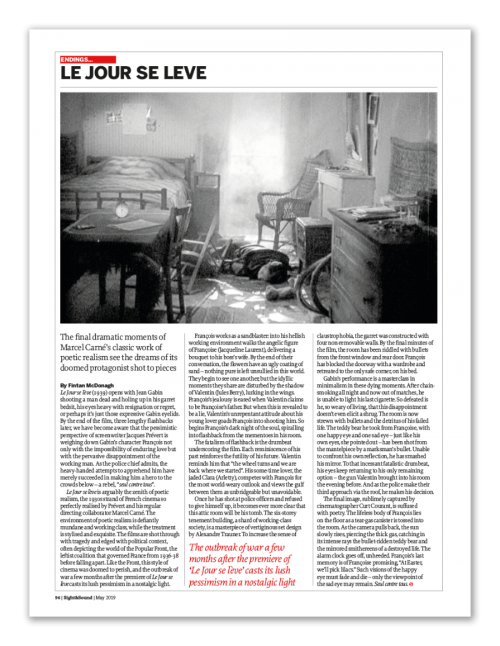
Endings
Endings
Le Jour se Leve
The final dramatic moments of Marcel Carné’s classic work of poetic realism see the dreams of its doomed protagonist shot to pieces. By Fintan McDonagh.
Further reading
-
The Digital Edition and Archive quick link
Log in here to your digital edition and archive subscription, take a look at the packages on offer and buy a subscription.




